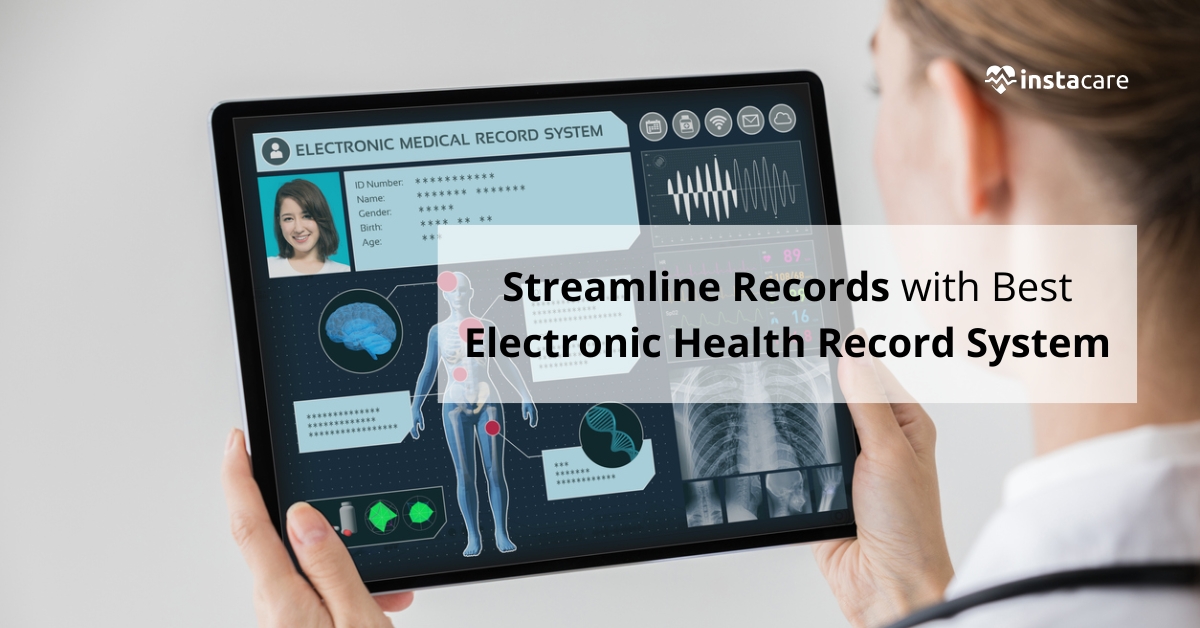Last updated on Wednesday, 9, April, 2025
Table of Contents
Streamline Records with Best Electronic Health Record System
When it comes to health, nothing can compare to the quality of record delivery by the Electronic Health Record system. While traditional paper filing systems may have been reliable in the past, they are now overwhelmed with details and paperwork that can be hard to keep up with. To manage these large volumes of information in a way that is safe, fast, and organized, many medical institutions are turning to electronic health systems – tools designed specifically for streamlining their records management processes. In this blog post, we’ll explore how a modern electronic health system can simplify record-keeping and improve patient care. We’ll look at why these solutions are becoming increasingly popular within the healthcare industry as well as discuss some best practices for implementing them effectively. So if you’re ready to make your day-to-day operations smoother while improving patient satisfaction – read on!
What is an Electronic Health System (EHS) and why is it important for streamlining records
An Electronic Health System (EHS) is a digital platform used by healthcare providers to manage patient information, streamline records, and improve patient care. At its core, an EHS is essentially an electronic health record (EHR) that provides a platform for real-time access and exchange of information between different providers.
One major advantage of an EHS is the ability to improve communication and collaboration between different healthcare stakeholders, including doctors, nurses, pharmacists, and other care providers. This not only improves efficiency and reduces errors, but also helps to improve the overall quality of care. Thus, an EHS is a vital tool for healthcare providers seeking to improve quality of care and offer streamlined services to patients.
How EHS helps reduce paperwork and streamline processes
The Electronic Health Record Software has revolutionized the way healthcare institutions store and manage patient data. With Electronic Health Records systems, EHS has now become a powerful tool to help reduce paperwork and streamline processes. EHS gives healthcare providers with instant access to a patient’s medical information, allowing for quick medical diagnoses and reducing the need for paper-based methods.
This not only saves time but also reduces the likelihood of human error, making patient care more efficient and effective. By utilizing Electronic Health Record Software, healthcare providers can focus more on providing exceptional care to their patients, while EHS handles the administrative tasks behind the scenes.
Benefits of using EHS to access patient records quickly
In this fast-paced world, time is of the essence. With electronic health record implementation, doctors and healthcare professionals can access patient records quickly and efficiently, which translates to better patient care. EHS provides a streamlined approach to accessing health records while also offering real-time updates on patients’ treatment progress.
This has made it possible for healthcare providers to collaborate effectively and come up with more personalized treatment options for patients, leading to faster recovery times and improved overall health outcomes. Additionally, EHS helps reduce administrative costs by eliminating paperwork, allowing healthcare providers to focus more on improving patient care. It’s easy to see why electronic health record implementation has become a crucial part of modern healthcare, delivering better results in the most efficient way possible.
View More: Simplifying Record-Keeping with a Patient Record Management System
Steps to create an efficient EHS system in your practice
When it comes to creating an efficient EHS system in your practice, one important step is electronic health record adoption. By implementing electronic health records, you can streamline your healthcare operations and improve patient care. With EHRs, your practice will no longer have to rely on paper records, which can be time-consuming and prone to errors.
Additionally, EHRs can help you to provide more personalized care to your patients by allowing you to easily access and analyze patient information. With all of these benefits, it’s clear that electronic health record adoption should be a key component of any effort to create an efficient EHS system in your practice.
Strategies to ensure patient data is secure within the Electronic Health Record System
In today’s digitized healthcare landscape, electronic health record (EHR) systems have become a cornerstone of modern medicine. While they have revolutionized the way healthcare providers store and access patient data, there is no escaping the fact that EHRs are still prone to data breaches and cyber-attacks. That’s why implementing strategies to ensure patient data is secure within the EHR system is critical.
From advanced authentication protocols to data encryption and employee education, there are a number of proactive approaches that organizations can take to safeguard sensitive patient data from unauthorized access or theft. By investing in robust security measures and training their staff on best practices, healthcare organizations can help mitigate the risks and protect the privacy of their patients.
Conclusion
To summarize, an electronic health system is the perfect way to streamline records and enhance patient care. It offers a multitude of benefits, from eliminating paper-based storage and record keeping to ensuring timely availability of medical history for healthcare providers. Additionally, it helps ensure that data is securely guarded, as all information is encrypted and stored in a cloud environment; this allows for increased security standards and policies, resulting in greater privacy control.
With its streamlined features, an electronic health system makes it easier to manage records and patient care effectively. The long-term use of this system boosts efficiency and creates better outcomes for both patients and healthcare providers alike. Overall, making the switch to an electronic health system is a worthwhile investment for any medical organization looking to increase productivity while providing superior patient care.


